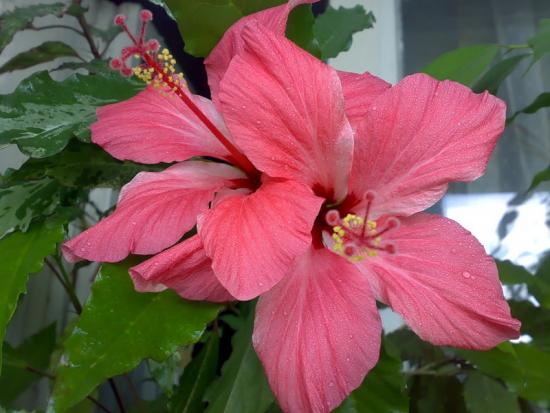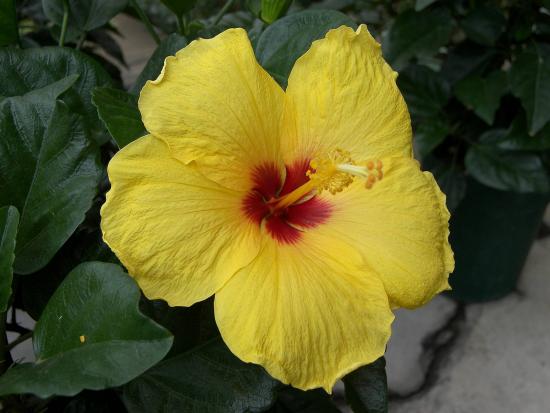How to replant hibiscus at home: step-by-step instructions and care

Representatives of the Hibiscus genus from the Malvaceae family have firmly taken their place in indoor floriculture. The most commonly grown hibiscus is the Chinese rose. Given its rather large size and rapid growth, the plant needs regular replanting. We will try to tell you how to transplant hibiscus at home.
Content:
- When and why do you need to replant hibiscus?
- Instructions for transplanting hibiscus
- How to properly care for hibiscus after transplantation
When and why do you need to replant hibiscus?
Almost all indoor plants need replanting sooner or later, hibiscus is no exception. Reasons for transplantation may be:
- rapid growth of the plant and development of the entire volume of the planting capacity
- replacing soil after purchase
- purchasing a more stylish pot
Time of year to transplant
Almost all indoor hibiscus have a fairly long flowering period, which is followed by a dormant period. Most often, the plant begins to actively grow and gain color with the onset of March. The active growing season ends in October.
During this period, the plant can grow buds several times. Based on the life cycle, the best time for replanting is March.
The awakening processes that have begun will accelerate rooting and reduce adaptation time. Transplant Possible in summer too. Transplantation in autumn is undesirable.The plant enters a dormant state, its life processes slow down. Important! Hibiscus should not be replanted during flowering.
How many times to replant
When grown properly, hibiscus can grow to quite a decent size even when grown indoors. The height of the plant reaches 1.5, and sometimes up to 3.0 m. This indoor flower grows especially quickly in the first three years, at which time it needs to be replanted annually, and in some cases once every 6-7 months.

Mature plants require less frequent replanting. Unnecessarily, they should not be replanted more than once every two to three years.
Consequences of untimely transplantation
If the plant is not replanted after purchasing it in a store, this can lead to stunted growth, development of pests, and lack of flowers. Flower producers grow their products in soil enriched with growth stimulants. This cultivation gives only a short-term effect of good growth.
If the roots of a plant are completely entwined with a clod of earth, then it will begin to suffer from a lack of nutrients, lag behind in growth, and lose its decorative appearance. Hibiscus not only stops blooming, but also loses its leaves. In order for the plant to tolerate the procedure more easily, several rules must be followed when carrying out the procedure.
Instructions for transplanting hibiscus
Selection of soil and pot
Considering that the plant will grow in the new soil from one to three years, it should be quite fertile. The soil mixture for replanting hibiscus should be composed of the following components:
- turf land 2 parts
- rotted humus 1 part
- peat soil 1 part
- sand 1 part
All components must first be disinfected and only then mixed.To obtain a more balanced mixture, for every two kg you need to add 100 g of wood ash and 20 g of complex mineral fertilizers for indoor plants. We must not forget about drainage material. Expanded clay and broken brick are suitable for this.
Pot
Taking into account the rapid growth of young hibiscus, you can take a new pot with a volume one third larger than the old one, especially if the root system of the plant is heavily entwined with a lump of earth in the old pot. Adult hibiscus grow in large tubs or flowerpots.
If the size of the root system allows you to leave the plant in the old pot, you just need to transplant it into new soil. If the dimensions of the above-ground and underground parts have outgrown the dimensions of the landing tank, it is replaced with a larger one. In the period between transplants, the top layer of soil in the tubs with adults is changed once a year.
Video about transplanting and pruning hibiscus:
Transfer
Before starting the procedure, the flower must be removed from the old pot. To make the process easier, the plant needs to be well watered a few hours before. Having taken out the hibiscus, you need to inspect its roots. If they are light and elastic, and there are no traces of pests in the soil and it does not have a putrefactive odor, the roots do not need to be freed from the earthen clod.
It is enough to remove only the top part soil. If there are rotten roots or traces of insects are visible, the old soil must be removed. Rinse the roots with water, cut off all rotten parts and treat the root system with a solution of Fundazol.
The following instructions will help you replant hibiscus correctly:
- make holes in the bottom of the pot for water drainage
- pour a 4-5 cm layer of drainage material
- try hibiscus to fit pot size
- add a layer of soil
- install the plant, the distance from the earthen ball to the top should be 5 cm
- by removing or adding soil, achieve the desired position of the hibiscus in the new pot
- evenly fill the soil, filling all the voids between the plant and the walls of the pot
- after filling the pot with soil, the root collar should remain at ground level
- place the flower pot in the tray and water it generously
- wait until all excess water has drained and remove the pan
- if the soil has sagged after watering, it needs to be replenished
The success of the transplant depends on further care.
How to properly care for hibiscus after transplantation
To make the plant less painful, it is advisable to move it to its original place. However, if direct sun falls on the plant, the flower must be protected from its rays during rooting. In the case when the air in the room is dry, and this usually happens during the heating season, the plant is provided with additional humidity. To do this, you need to spray the air 2-3 times a day.

You can install a special humidifier. It happens that 7-8 days after transplantation the leaves wither and their condition does not improve after watering. In this case, you need to reduce the load on the roots of the plant. To do this, it is advisable to carry out pruning shoots. Some can be shortened by a third, and some can be cut off altogether.
During this period, it is important not to overwater the plant, since the suction system of the roots does not work fully after transplantation. Even if the flower has lost all its leaves, after 30 - 35 days new buds appear and it recovers very quickly. If trimmed parts of the hibiscus remain after transplantation, they can be used for cutting and rooting cuttings.











Comments
When replanting hibiscus, I try to do the transshipment as described in the recommendations, and after replanting and abundant watering, do not water the plant for several days. I have not trimmed the shoots, but now I will trim them.